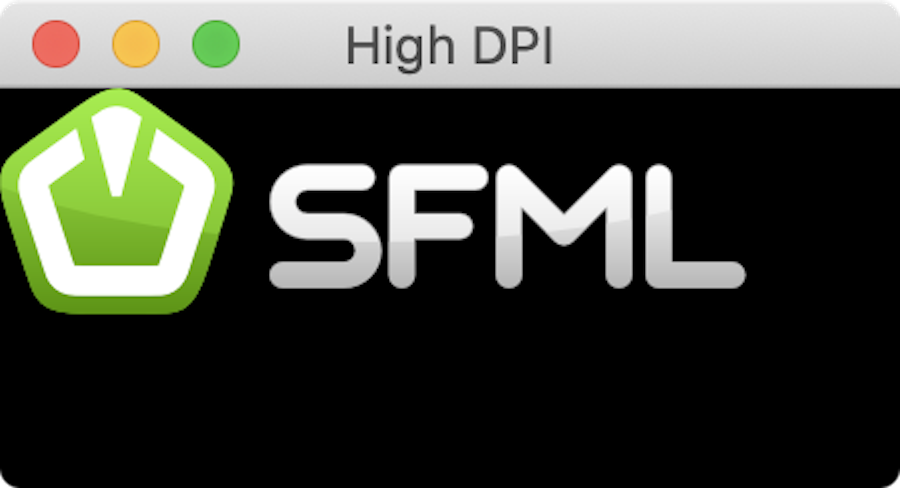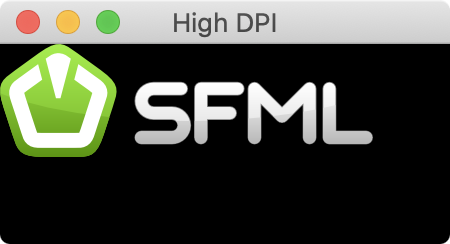New issue
Have a question about this project? Sign up for a free GitHub account to open an issue and contact its maintainers and the community.
By clicking “Sign up for GitHub”, you agree to our terms of service and privacy statement. We’ll occasionally send you account related emails.
Already on GitHub? Sign in to your account
Idea to improve high DPI handling on OS X #1817
Conversation
|
Maybe taking one step back again, I think there are essentially two issues here:
I'm not as deep into macOS nor do I have a retina display to fully understand the defaults and possible options. For the buffer/canvas itself, the idea was to provide an API which gives not just access to the window size, but also the non-scaled canvas size. That way you should be able to calculate the wanted difference yourself and if wanted render at "high DPI" while the window style itself is at scaled DPI. From my limited understanding, I'd suggest the following changes:
Do you think this makes sense? |
|
Thanks for the feedback!
Agreed. In particular, every Mac application should display high-resolution window decorations and fonts on a retina display. GUI applications with native controls should display high-resolution UI elements. Some legacy application (i.e. those built before high DPI support was widespread) do not do this, and instead have pixelated/scaled low-res UI elements (like in some of the screenshots I posted). These applications generally stick out like a sore thumb (Mac users tend to notice details like this), and this situation should be avoided if possible. That is the reason that the current solution/workaround of setting The problem with the current SFML functionality is that if you use high-res window decorations, you get a tiny window size. If you want a full-sized window (without manually scaling everything in your rendering code, keeping in mind that the display scale is not accessible with an SFML API), then the window decorations and fonts will be low-res. What this PR does is make the default mode for windows have high-resolution decorations and fonts, but keep the scaled window size, and simply scale the contents of the OpenGL view.
If I understand you correctly, that is what the new "default mode" of this PR does. Now, one potential issue with this approach is that graphics within the OpenGL view will not be rendered at high-resolution. That is the reason I introduced the If you believe that this window style adds extra complexity for little benefit, then I am completely fine getting rid of it. The consequence of that would mean that rendering high DPI graphics within the OpenGL view would not be possible. |
|
I currently don't know anything about high DPI, but I'm willing to do research into whatever is needed. This issue has been the reason I have not been able to dive into SFML on my Macbook Pro. 😭 |
Hi @yuupsup, would you mind giving this PR a try and let me know if it works according to your needs? Thanks! |
|
@jqdg Sorry, I never got a notification that you responded. PR means "pull request", correct? Do you mind working with me on how I can try the request? How do I pull the changes you've made? |
|
@yuupsup Yes, "PR" means "pull request". You can checkout this request locally by doing this: # Clone SFML (you can skip if you have done this already)
git clone https://github.com/SFML/SFML.git
cd SFML
# Check out branch of this PR locally
git fetch origin pull/1817/head:high-dpi
git checkout high-dpiIn the future, you can overwrite your local branch with newest PR changes like this: git fetch origin pull/1817/head:high-dpi -ufAlternatively, directly track the remote branch in the original repo: https://github.com/jqdg/SFML/tree/osx-high-dpi. |
|
@Bromeon Thanks I was able to get it. :) @jqdg I'm amazed haha, it worked. Using the default (the only one I have currently tested) style is displaying the correct window and image size. Edit |
Thanks for checking! Glad it looks like it's working for you. I suspect that the default style should work well in almost all cases (I only introduced the
There are some more CI checks that are needed. I think the maintainers would also need to decide that they want to adopt this design. I would definitely like to make whatever modifications are needed to get this PR accepted. It would be great to make working with high DPI displays easier on Mac OS. |
But isn't this also possible by adjusting the view after the fact? Say you have a 150% DPI scaling, if you as a library user somehow retrieve this scaling information, you could just zoom out the view by a factor of I still believe the HighDPI as a style is not the way to go, but stick to DPS scaling as default and later down the line provide a function that returns the "unscaled" canvas size, so the user can get that factor on their own. |
@eXpl0it3r, what do you think about the option to just remove the Perhaps as a first step, we could do the first (render everything scaled), and then separately (in a different PR) consider different options for public APIs to enable high DPI rendering? |
|
I think it's the way to go, unfortunately, I'm somehow having a hard time to fully understand what you answered to my question (it's me not you 😅). I mean the "Default style with scaling" looks kind of bad, but it's also not really representative of how it actually looks, since nobody would scale that much, correct? |
Yes, you're exactly right. I zoomed in the previous screenshots just to emphasize the differences. Normally, the difference would be subtle:
The point I was making is that the "scaled" approach will not be able to reproduce the "high DPI" approach pixel-for-pixel. So if a user wants to properly implement high DPI rendering, and if they care about these subtle differences, then there needs to be some way for them to enable high DPI mode for the OpenGL view. On the other hand, I believe that the "scaled" rendering is almost always good enough (and is certainly better than having all the graphics show up too small), and so I think that changing this behavior would be an improvement, even if (for now) there is not an easy way to enable true high DPI mode. |
|
Okay, then my assumptions were correct so far. But then doesn't my point still hold true, that you could expand/zoom out in the scaled view and render things at a higher resolution? |
Right, the scaled version prevents the use of more pixels. In the scaled version, every pixel rendered to the OpenGL view will be blown up to become a 2x2 block of pixels. That is exactly what is happening in the two screenshots that I posted previously. The SFML logo (included in the repo at Now, I try to replicate this behavior using the scaling, without high DPI mode. I use the new default window style from this PR, and create a half-sized window, and render the texture and 0.5 scale. What happens is that the texture is down-sampled to 186x56 pixels, and then drawn to the OpenGL view, which (as I mentioned above) will draw each pixel of the down-sampled texture as a block of 2x2 pixels. So I get an image that's the same size as the high DPI case, but pixelated. There is no way (that I am aware of) to obtain the same result as the "high DPI" screenshot using only the scaled mode. |
|
Okay, thank you very much to have all this patience with my stupid questions, just wanted to make sure I understand it fully. I am still for removing the HighDPI style and use the default DPI scaling. As a user, you enabled DPI scaling, so you should expect to have your applications scaled. Have support of High DPI will look like API wise, should be discussed at a later stage. Any objections to this, @SFML/sfml team? |
|
I got rid of the proposed |
82179f7
to
6a021c1
Compare
|
FYI: I've squashed the commits, so it looks a bit nicer in the git history. Thanks a lot for this suggestion! I hope, we'll get some more positive feedback as it makes it to various macOS users! 🙂 |
|
First success story: TankOs/SFGUI#88 🙂 Btw. do you want to continue the conversation on how to allow the user to decide whether they want to use high-dpi on the forum thread? |
|
I have a proposal, is it possible to make the HighDPI flag make everything render in high resolution, but keep the window size and coordinates the same? This is the default behavior in most other libraries such as SDL, and I'm confused as to why nobody pointed this out. |
I've been looking for this issue haha. I'm glad to see everything turned out well. Thanks again @jqdg for initially creating this pull request. |




Problem Description
SFML doesn't really have complete support for DPI awareness (it is my understanding that this is planned for SFML version 3).
This can be an issue on MacBooks with retina displays (among other situations). There are two possible cases:
NSHighResolutionCapableis set to true, and all windows appear to be half the size in each dimension as expected.NSHighResolutionCapableis set to false in the Info.plist file, and the whole app renders in low resolution.Both of these cases are highly problematic.
In case 1, by default, all windows and graphics will be drawn far too small to be usable. In order to render at the correct size, the application developer must scale all of the window and graphics sizes by the correct scale. However, SFML does not expose an API to identify if the display is high DPI, and to return the correct scaling. This is a fairly invasive change to the application code, and will require platform-specific code to identify the display scaling.
In case 2, everything draws at the correct size, but the window decorations and fonts are blurry. Furthermore, if one uses a raw executable (rather than application bundle) then it is not possible to set this option using Info.plist.
NSHighResolutionCapabletrueNSHighResolutionCapablefalseProposed Solution
I believe that the default behavior should be as follows:
If the user wants to avoid the scaled rendering, and instead put in the extra effort to support high DPI rendering, then they can opt-in by setting a high DPI window style.
This PR accomplishes this by adding a new window style
HighDPI(which has an effect only on Mac OS, but this could potentially be extended to other platforms). This style is not set by default. This will cause the window and graphics to render at the same apparent size on high DPI and low DPI displays, while retaining high-resolution window decorations and fonts. This is because if the style is not set, thensetWantsBestResolutionOpenGLSurfaceis set toNOin theSFOpenGLView.On the other hand, if the application developer wants to avoid possible pixelation from scaling the window, they can set the
HighDPIwindow style, which will callsetWantsBestResolutionOpenGLSurfacetoYES, and also enable scaling of window dimensions by the display factor. The developer will then need to manually scale all of the windows and graphics sizes in their rendering code to render everything at 2x.Tasks
How to test this PR?
From the above screenshots, we can see that the "default mode" preserves the advantages of setting
NSHighResolutionCapableto be false (everything renders at the correct size), while avoiding the blurry window decorations and fonts. Additionally, the application developer still retains the option to render everything in high resolution if desired.